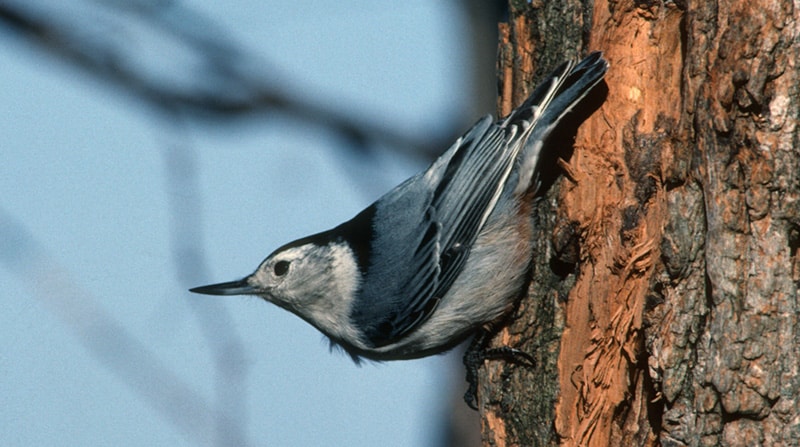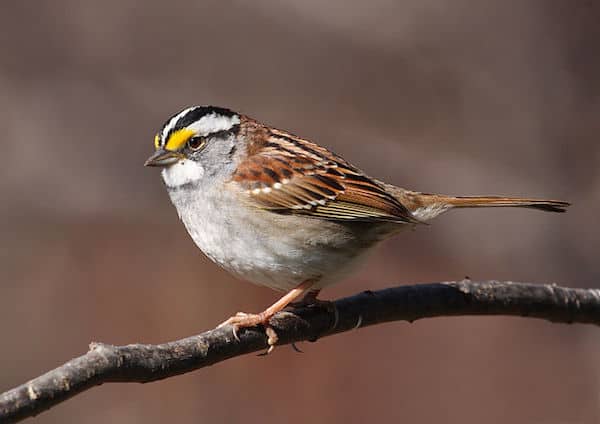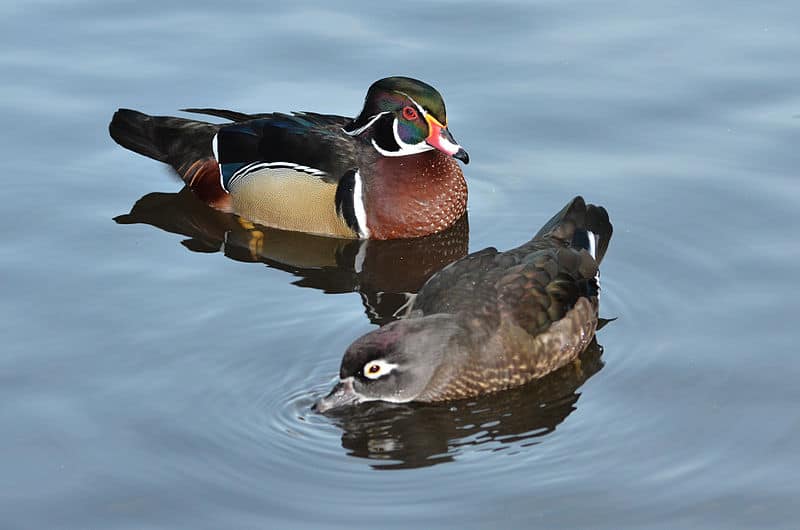The road is visible in snatches: smeared impressions of highway at the wave of a windshield wiper. Each sweep of the blade grants a moment of safety interspaced by leaps of blind faith.
. . .here’s the road . . . here’s the road. . . here’s the road. . .
It’s like a game. Connect the points with a line that gets you (safely) from here to there. Just for realism, just to keep the adrenaline flowing, every once in a while the image alters.
. . .here’s a car. . . here’s the medium. . .here’s a tree. . . HERE’S A. . .
But my reactions to these challenges are mechanical and indifferent. Fatigue has robbed the game of any pleasure now.
I’m tired.
Couched in soggy velour, wrapped in resignation and the passenger seat, is American Birds’ regional editor Bill Boyle. Visible in the rear view mirror: Pete Bacin ski, the J.J. Audubon of Lyndhurst, New Jersey; and David Sibley, the hottest thing to hit birding since the Phoenicians melted sand. Beneath us is a SAAB 900 Turbo. Behind us, the 1983 Bird-a-thon.
We had mapped our assault at a strategy session in March. Finding 200 species was going to take more than skill and luck. It was going to take planning. There are, in New Jersey during the second week in May, about 190 species of birds that are front-line possibilities for a Big Day—though, admittedly, some like pied-billed grebe and wild turkey are tucked into out-of-the-way nooks and crannies of the state and, given the time factor, become untenable candidates for a working hit list.
There are another 40 or so birds that fall into a category marked “present but not certain to be seen.” On the reasonable end of the scale, these include birds such as the American bittern and alder fly catcher—birds that, due to weather conditions or timing, may be missed. On the distal end of the scale are birds such as curlew sandpiper and mourning warbler—birds that are just few and far between. Beyond these 230 possible species is a vast and not-to-be-seriously-considered mass of possibilities labeled “dreams.”
All of us agreed quickly that the official bird-a-thon date of 21 May was too late. The wintering birds would be gone. We opted, instead, for a 14 May run with a second assault planned for 21 May—just in case. We dismantled our recordsetting route of 1982 (when we saw 185 species, breaking the New Jersey Big Day record of 171 and suggesting that 200 species in 24 hours was possible outside of Texas or California) and rebuilt it from scratch by ruthlessly cutting unproductive or redundant sites, adding locations of greater promise, and plotting a course that was mindful of every conceivable contingency—traffic, tides, gas stops, coffee shop locations. We included fall-back locations (sometimes three and four per species) for birds missed and alternative routes in case fortune had placed an other wise out-of-the-way species in the bag. We subjected everything to a merciless down-to-the-minute scheduling and still, somehow, managed to buy one hour of undesignated time: a buffer against crisis, a coin to cash in on a wind fall condition (a warbler fallout, bonus shorebirds) or to use to track down misses at the end of the day.
Everyone had a site that was too dear to drop; everyone had another that he deemed too unproductive for the price. But when it was over, we were sure that we had a winner. Two hundred species was going to be close. And we even adopted a name for the ad hoc combatants: the GUERRILLA BIRDING TEAM; and a motto: HIT AND RUN.
What we needed was a car—not just any car, either. What we needed was a car that could meet some pretty tough and unusual demands. It had to be fast enough to melt the white line on an interstate and tough enough to gouge its way along a pine barrens goat path like a peccary in heat. It would have to handle like a New York City taxi with the promise of a $50 tip in the driver’s ear, and be able to go from flat out to flat zero in less time than it takes to say, “Hey, what’s that bird sitting on the wire?” It would have to be engineered for comfort (to offset the effects of 24 hours in the saddle), to provide excellent visibility in 360 degrees (plus a sunroof), and to offer ample trunk space for scopes and tripods and four doors that opened WIDE for fast exits and quick re-entry.
In other words, what we wanted was the ultimate birding car. After sifting all of the domestics and imports through the fine mesh of established need and 15 years of piston worship, we found there was really only one top contender for a bird-a-thon staff car. But, would SAAB be willing to lend us one for the assault? The answer: Yes.
Ground fog lay heavy over the remains of glacial Lake Passaic, dying, now, these 10,000 years. We rolled to a halt on the old dike road. Four doors opened as if moved by a single hand. A dark figure emerged from each and moved quickly to form the points of a ritual square. Heads bowed, we waited.
One by one the night birds betrayed themselves. One by one we chanted their names aloud—Virginia rail, sora, common moorhen, American woodcock. Somewhere, an eastern screech-owl chuckled softly. Somewhere a least bittern and an American bittern did not, and would not for all the cues and promptings that poured from Bill Boyle’s cassette. If they laughed at us, they did it silently (because even the laugh of a bittern is known to Sibley and Boyle). “Time,” said Bill. Without protest we left the dike behind. The Great Swamp was Bill’s fief. For four weeks he had stalked its pools and hardwood glades as he staked out birds on his assigned hit list. If he couldn’t find them, they weren’t to be had. A shadow of a bird flashed through the headlights. “Solitary sandpiper,” said three voices; “Spotty,” said one. Without prompting or discussion each of us traced back along lines of thinking that led to our individual identification. in search of a flaw in our reasoning. “You’re right,” the lone dissenter proclaimed quickly. “Soiltary. I thought it was smaller at first.” Bill guided us to a stop. “Great horned owl nest over in the trees with two young in it,” he explained as he rolled down the window. He need not have bothered, not with the window or the identification. The impatient screams of hungry owl pups made even the night uneasy.
We left the swamp at 1:30, right on schedule, with six birds on the “must get” list in the bag, hut with both bitterns unaccounted for. It was 20 minutes to Troy Meadows— automatic back-up site for fresh water nocturnals.
We jumped the chain-link fence in commando fashion and navigated the narrow catwalk leading out into the marsh on the balls of our feet. It is an old walkway, repaired at intervals by the power company but always at a pace several steps behind need. The skeletal frames of high tension towers loomed overhead. The air crackled with their malevolence. Troy surrendered nothing to our list. The catwalk and the hope that lured us farther and farther out into the marsh cheated us. Bitterns were as silent as the shadows cast by stones.
West on Route 80 now, the road that spans the continent. Racing against dawn to Allamuchy Mountain, we hoped to add wild turkey to the list with a fast throw of the dice. Gravel flew in our wake as we pulled up under the shadows of sugar maples. Night-sharpened senses revealed the acid bite of dairy cattle in our noses and the chilling call of a distant rooster in our ears. Bill hit the tape and the ersatz gobbler stirred to life, volume full: GOBBLEOBLOBLOBLOBL OBLOBL. . . OBLOBL. . .”
The SAAB careered into the parking area near the old elevated railroad bed at Waterloo with only the mildest application of brakes.
Catapulted from the car, we marched double time up the tracks overlooking the river. All signs of fatigue were gone now. Put in a blender, separated in a centrifuge, we could have provided enough adrenalin to make a dead brontosaurus backstroke across Saskatchewan. This was the magic hour before dawn on the day that transforms all things avian into treasures.
Every bird is a prize on a bird-a-thon. All birds count as one, no matter how common or how rare; a cowbird rates as high as a Bachman’s warbler. And if the hour that bonds the day to the night is one filled with treasure, Waterloo is the mother lode.
One by one we gathered them: cardinal, towhee, wood thrush, phoebe, catbird, and robin. Mixed in with the amethysts and garnets were emeralds and rubies, the ones that might have been missed—kingfisher, ruffed grouse, solitary vireo, purple finch, and a pearl of great price, a windfall extra—olivesided flycatcher. And just before leaving, David did it again—second year in a row, a pick-up-from-behind black-billed cuckoo that tried to sneak across the road when our backs were turned. It was 6:30. We were behind schedule.
Allamuchy Boy Scout Camp is one of those clutch, hole-card stops. It is a place to get those makeor-break species, the borderline expecteds, and a place to intercept first-run misses. In ten minutes, we picked up both waterthrushes, brown creeper, cerulean warbler, and plugged a few ominous holes in our passerine list.
With both scheduled upland songbird sites in the rear view mirror, Pete did a count and came up with 91—two birds ahead of 1982’s record-setting run. So far, so good.
After quick but heated debate we opt to bypass Bull’s Island and shoot south, making a quick, unplanned stop at Princeton. The decision means that we forfeit cliff swallow—but we buy a precious hour and a half. One sure bird is not worth that high a price.
Institute Woods, Princeton, is saturated with birders hot on the trail of peak-week warblers. We pick up warbling vireo, shift black throated green and Nashville warblers from the lost to the found column, and escape without losing too much time in exchanges of information with friends and fellow birders.
Assunpink Fish and Gamelands surrenders blue grosbeak, northern bobwhite, and orchard oriole with out a struggle. The lake yields a lingering common loon, and turkey vultures dot the horizon.
This marks the half-way point on the itinerary. We stare at our watches and look at each other in disbelief. It’s only 10:30. Ahead lies 70 miles of sterile sand and stunted pines called, appropriately, the barrens. For birding purposes, its sole advantage seems to be that the roads are straight, uncluttered by traffic, and lightly patrolled. With little to do but wait, everyone relaxes.
A detour on Route X directs us through a rabbit warren of cottage communities. We emerge onto Route 70 not far from Lebanon State Forest. We decide to drop in for its cluster of semi-tough species (Contingency Plan 7b). The sidetrip is good for summer tanager and eastern bluebird, but red-headed woodpeckers elude us. After a decent interval (30-40 seconds), we move out.
Hit and run. Brigantine National Wildlife Refuge is a “must stop” on any Big Day circuit. No place offers easier access to more salt marsh species. We hit the dikes at the crack of noon, round them in the allotted one-hour limit, and encounter difficulty only once—a near-mutiny when a curlew sandpiper in breeding plumage plops down in front of us; David has to be dragged back to the car. Brig was a treasure trove. Along with the must-gets like gullbilled tern and white-rumped sand piper, we garnered both teal, lingering shovelers, a ruddy duck, a merlin, and another gift—American avocet.
Pete checked the list on the exit road. And then he checked it again. The count stood at 171! The time said 1:15 p.m. Last year’s count at this point was 158. Thirteen birds ahead of last year and almost one hour ahead of schedule. Incredible.
The back side of the Stone Harbor heronry offered a quick eye ball-to-eyeball confrontation with a yellow-crowned night-heron. Great Channel produced a small clutch of red-breasted mergansers. Higbee Beach yielded a chat (but not without a fight), and Pete B. came through with a clutch save on a near-miss—a late, soaring broad-winged hawk.
The South Cape May Meadows was good for piping plover, purple sandpiper, black scoter, and pec toral sandpiper (a gift). We skipped Cape May Point. It had nothing left to offer us.
Now it was our turn, David’s and mine. From here on it was a mop up operation—a point-to-point search for birds missed and for birds tied down. A search of the list showed that we still needed (incredibly!) killdeer and (not unexpectedly) horned lark. The Cape May County Airport was the third and second line of defense of each, respectively—and it was, too.
Cape May County Park gave us the red-headed woodpecker we had missed at Lebanon State Forest (but not the red-bellied that was sup posed to be there). The yellow throated warbler couldn’t be coaxed into calling, and Moore’s Beach Road grudgingly surrendered a prothonotary warbler and a hairy woodpecker (second fall-back sites for both species)—but again, no red-bellied woodpecker.
Out on the marsh, luck surrendered the least bittern that fate had cheated us out of 18 hours earlier, and it traded us reeve for the lesser yellowlegs that should have met us there. Pete did it again. A distant speck became an immature bald eagle under Questar-assisted judgment. And just before leaving, a raptor flashed overhead whose manner and movement shouted “PERE GRINE”—Number 186—a new state record!!!
During the ensuing period of wholesale congratulations, David coolly watched the bird’s progress and painfully announced, “It landed on the new peregrine hack tower.” Pete scratched the bird from the list.
It was a shaken foursome that headed for Turkey Point. To have the record taken from us in such a fashion shocked our resolve. When the Kentucky warbler couldn’t be coaxed into song at our one and only Kentucky site, it sent spirits plummeting. Two hundred species was slipping from our grasps.
A shoestring lesser yellowlegs at the Maurice River Bridge gave us back the record. Dividing Creek produced yellow-throated warbler, Acadian flycatcher, hooded warbler, and, finally, a red-bellied wood pecker at our fourth and last fallback location.
Dusk found us overlooking the marshes of Delaware Bay. King rails sounded off all around us. In the distance, a whip-poor-will called, then a chuck. The count stood at 194. We could still go to Marmora for black rail and Greenwich for common barn owl, or we could pack it in and try for 200 next week.
We packed it in.
On May 21 we never really had a chance. Off and on, there was rain. Each site seemed to come up short handed—or break even only at a greater expenditure of time or effort. And then it started to rain. And then it started to pour. Two hundred species were not going to happen in 1983. We had to settle for May 14’s 194, six birds shy of our mark—but still a New Jersey record.



